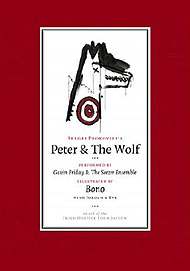 Matej Novak wrote this review.
Matej Novak wrote this review.
For a piece of music, regardless of when it was written, to be considered truly timeless, it must stand up to any and all tests of style, genre and instrumentation; in short, anything a future arranger may throw at it. And while it may “work” with just about any instrument or orchestra, the trick is coming up with the right mix, the instruments and sounds that will most complement the piece while retaining its original character. The first requires a skilled composer; the second, a deft and sensitive interpreter. The latest version of Peter and the Wolf has the good fortune of both — two of the latter, in fact — but the musical aspect is only the beginning.
Arranged by Gavin Friday and Maurice Seezer, and performed by The Friday-Seezer Ensemble, the Bloomsbury edition of Sergei Prokofiev’s Peter and the Wolf is a small gem of a boxed set, featuring a book illustrated by U2 frontman Bono — with his daughters, Jordan and Eve — and a CD of the Friday-narrated recording, including several CD-ROM extras.
Though it may seem strange to have Bono — a man known primarily for his music and political activism — illustrate the tale, the Irish singer tackles the project with skill, ease and vigour. The enhanced portion of the CD shows Bono standing before massive canvases, drawing shapes that become forms, figures and eventually living creatures, while his daughters fill in small details, mainly flowers. He is obviously very comfortable with a pen and paintbrush and has a clear vision of what it is he is trying to create.
The end result — in grey, black and red — demonstrates a subtle quality of anarchy and chaos, if such a thing is possible, reminiscent at times of Dave McKean’s work. Edges are left unfinished, lines uneven, and each imperfection is obviously as much a part of the work as every deliberate stroke. Sometimes it’s even hard to tell the difference. But there is also a subtle trickery to the art. Perhaps the book’s most innocent-looking picture is also the most deceiving: the simple form of the wolf’s head becomes two hunters, shotguns drawn, if you just look hard enough. And make no mistake, each character has a very definite, unique personality, brought to life not only by how that character looks, but also by how that specific character is drawn. Peter is even modeled after Bono himself, a young rebel in black sunglasses and an angry tuft of black hair.
The music serves to bring the characters — and story — even further to life. “We decided not to go the orchestral route with it as it had been done so many times before,” writes Friday on the project’s Web site, “and yet despite this we wanted to stick to Prokofiev’s original intention, which was to introduce children (and adults) to the instruments of the orchestra.” To that end, Friday and Seezer brought together traditional orchestral instruments — piano, guitar, bass, cello, piccolo, flute — with some more unlikely ones — accordion, bass clarinet, tuned percussion, banjo, mandolin. So not only is each character associated with a motif and a particular instrument, the unique sound of each instrument makes each character that much more special. Sections where the entire ensemble plays together are richly textured, bringing together elements of classical, folk, jazz, world music and other styles. It doesn’t just kinda work, it really works.
If all this weren’t enough for a perfect, cohesive whole — which it is — the final product is solidified by Friday’s narration. His calm, low, rumbly voice is hypnotic, and his vocalizations are just subtle enough not to be comic, at least not in the pejorative sense. His familiarity with and fondness for the story are apparent. Not only does his reading completely immerse the listener in Peter’s world, it also fosters a special appreciation for in the work in those already familiar with the story and newcomers alike.
Though the project follows up on Friday’s previous narration of the story with the Royal Irish Academy of Music at the Irish Hospice Foundation event, Con Anima, in 2000, the sound, look and feel of the finished product are wholly original. (The recorded version again benefits the Irish Hospice Foundation and international hospice care for elderly and terminally-ill patients.) It is also thoroughly modern-sounding; quite an accomplishment considering Prokofiev composed the work in 1936, and performed it to an initial lukewarm response. Given that the universal appeal of Peter and the Wolf has lasted this long, and that a very talented group of artists has given the work such a thoughtful interpretation, there is little chance of history repeating itself in this instance.
(Bloomsbury, 2003)
